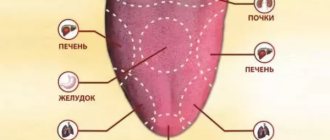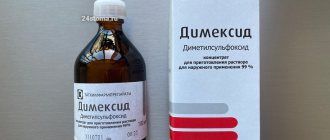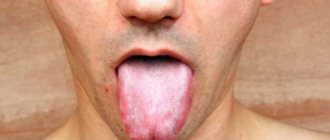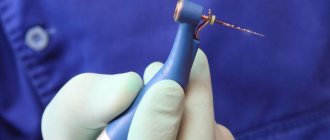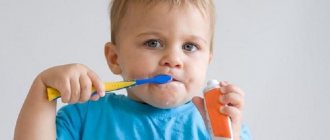Back to list Previous article Next article
20.09.2019
Vote
Many pediatricians call the green color of stool one of the alarming signs of a deteriorating condition of a small child. In the first two to three years of life, most children are not able to clearly talk about their well-being, so parents usually rely on various external manifestations of health problems. However, even if green feces appear, you should not panic - the reason may turn out to be quite harmless.
Intestinal infection
A sign of the development of infection in the intestines of a small child is the presence of shiny green streaks in the stool. This is what mucus looks like, containing a large number of intestinal bacteria. Often the infection enters the child’s body during teething, when the baby puts everything in his mouth to relieve itching in the gums. If green streaks appear in the stool, you should consult a pediatrician, at least by phone. If there are no other symptoms, it may be enough to give up complementary feeding for a while and strengthen hygiene measures: iron the baby’s clothes, boil nipples and wash toys with soap.
Teething: how to help your baby?
When do the first teeth appear?
The timing of teething in children can vary significantly.
They depend on the physical constitution of the child, the nature of his nutrition, individual characteristics and inherited genetic parameters. On average, teething begins at 6–8 months of life. However, for some babies, the first tooth may appear at 4 months or even earlier, while for others it may appear closer to a year. For some children, teeth erupt painlessly, without causing much concern. But most babies experience discomfort at this time. The child may become capricious, irritable, wake up periodically at night, and refuse to eat. The most common warning signs of teething are excessive salivation, redness and swelling of the gums, and itching in the gums. The baby may also experience increased body temperature and diarrhea.
What are these problems associated with and how to alleviate the child’s condition during teething?
Increased salivation during teething
Excessive salivation is due to the fact that growing teeth irritate the nerve receptors of the salivary glands, and they begin to show their activity. As a rule, drooling appears 4-6 weeks before tooth eruption. Due to excessive saliva production, the baby may develop redness on the skin around the lips and on the chin. To avoid this, wipe your child's face with a soft cloth throughout the day. If irritation already exists, you can lubricate the skin in this area with baby cream or cream containing dexpanthenol while the baby is sleeping.
Pain syndrome during teething
The sharp edge of the tooth, breaking through the sensitive gum tissue, irritates the nerve endings and causes unpleasant pain in the baby. It is because of this that the child becomes capricious and irritable. At night, as a rule, the pain syndrome is more pronounced, and therefore the baby may often wake up at night. During this period, you should try to give the baby as much attention, affection and care as possible. You can try to distract your baby from “dental problems” with a new bright toy or rattle. It is also advisable to maintain the child’s usual routine, not introduce new complementary foods, and not do vaccinations.
If pain during teething is severe, you can use special gum gels with an analgesic effect. These products contain the anesthetic lidocaine, which has a local anesthetic effect. The gels may also contain chamomile extract, which has an anti-inflammatory effect. A small amount of gel (the size of a small pea) should be applied to a clean finger and gently rubbed into the area where the tooth is erupting. This procedure is carried out after meals and before the baby goes to bed. Gels can be used a maximum of 6 times a day with breaks of at least 3 hours.
Gel in tube “Kamistad Baby”, 10 g
You can try giving your baby a gentle gum massage. To do this, gently massage the child’s gum with a clean finger or gauze swab dipped in boiled cool water. Pressure on the gums during massage reduces pain.
Itching during teething
Many mothers notice that with the beginning of the appearance of the first teeth, the child began to put everything in his mouth. He does this to scratch the irritated gum. If you look into your baby's mouth, you will see that the gums above the erupting tooth are red and swollen. To help relieve itchy gums, there are special teethers available. They can be made of silicone or food grade rubber. Some of them contain liquid filler – water. Before giving such a teether to your baby, you can cool it in the refrigerator for 20 minutes (not in the freezer!). Cold soothes itching, relieves swelling of the gums, reduces inflammation and relieves the baby from discomfort.
Increase in temperature during teething
There is a widespread belief among parents that the appearance of teeth in a baby is accompanied by an increase in temperature. In fact, this is not always the case. Fever during teething is usually associated with a weakening of the body's defenses, decreased immunity and a viral infection entering the child's body. Thus, if the baby’s temperature rises, you should call a doctor and rule out all acute conditions. If the doctor is sure that the child does not have any infectious process, then an increase in temperature to 37.5 ° C can be considered the result of gum inflammation.
If the temperature rises above 38.5 °C, antipyretics based on paracetamol or ibuprofen can be used to reduce it. These drugs can be given to babies in strictly age-appropriate dosages.
Stool disorder
During teething, many babies experience loose stools. There may be several reasons. Firstly, it is the swallowing of large amounts of saliva and increased peristalsis; secondly, decreased immunity and disruption of intestinal microflora. If an infection occurs, the child may experience diarrhea. In this case, the stool becomes watery and happens more than 4 times a day. To clarify the diagnosis, the baby should be shown to a doctor.
Refusal to eat
During teething, some babies may be reluctant to eat or refuse to eat at all. This is due to the fact that when feeding, the feeling of pain and discomfort in the gums increases. There is no need to try to force feed your baby: the appetite will be restored immediately after teething.
Caring for your first teeth
Immediately after the first teeth appear, they need to be properly cared for. It is important to remember that one single tooth needs the same careful care as thirty-two. First, parents brush their child’s teeth without toothpaste: the baby will need it after 1–1.5 years, when the teeth have fully erupted and are visible above the surface of the gums.
The easiest way to care for your first teeth is to use a piece of gauze. Wrap your index finger in gauze soaked in warm boiled water and gently wipe the child’s gums. This procedure can be carried out no earlier than 30 minutes after eating to avoid regurgitation.
You can also use a special silicone brush that is placed on the parent’s finger. This brush is a transparent cap, at the end of which there are many short silicone hairs or pimples. Using this device, you can remove plaque from the first teeth and massage your baby’s gums. After cleaning, the brush should be washed with soap and rinsed thoroughly with warm water.
To care for the oral cavity of babies, you can use special wipes. They are impregnated with a solution containing xylitol, which prevents the growth and development of bacteria that cause caries.
At about 1 year of age, when the child has already erupted 8-10 baby teeth, you can start brushing his teeth with a toothbrush. The bristles on a baby's toothbrush should be soft so as not to injure his teeth and gums. It should be made of synthetic material - polyester. This is due to the fact that natural bristles are difficult to dry and germs accumulate in them more quickly. When choosing toothpaste for children, you need to look at the age indicated on the package. The main rule is that the paste should not contain fluorides. Children under 3–4 years of age often swallow toothpaste, and fluoride is a toxic substance for the child’s body.
Children's toothpaste "Asepta Baby" from 0 to 3 years, 50 ml
Gel paste for protecting the first teeth from bottle caries and preventing inflammatory diseases of the baby’s oral mucosa.
More details >
When the child turns 1 year old, he needs to be seen by a dentist. The doctor will examine the baby for any oral diseases and, if necessary, give parents recommendations on caring for the baby’s teeth.
Every tooth has its time
Normally, the baby's lower incisors appear first: this occurs at 6–9 months. Next come the two upper incisors - at 7-10 months, then, at 9-12 months - the lateral incisors: first the two upper, then the two lower. After this, one molar appears on each side: at the top - at 12-18 months and at the bottom - at 13-19 months. Then the canines grow: first the upper ones - at 16-20 months, then the lower ones - at 17-22 months. Finally, the second lower molar erupts at 20–33 months and the second upper molar at 24–36 months. Thus, at 2.5–3 years the baby already has all 20 baby teeth.
Permanent teeth begin to appear at around 6 years of age. Baby teeth fall out in the same order in which they appeared.
When should you see a doctor?
Violation of the general condition of the child during teething. Vomiting and diarrhea can be symptoms of an intestinal infection, which without timely treatment can cause dehydration in the baby. This condition occurs because just after 6 months of age, when the child begins to develop teeth, his innate immunity, transmitted from the mother, weakens, and the baby becomes defenseless against various infections. When teething, the baby puts everything into its mouth and often sucks its fingers. In this case, it is the oral cavity that can become a gateway for intestinal infection.
Temperature increase. Fever should not be attributed to “teeth” - it is better to call a pediatrician at home, who, after examining the baby, will help to understand the causes of this condition.
Late teething. If a child is one year old and does not have a single tooth, he needs to be shown to a pediatrician or dentist and examined. First of all, the pediatrician will prescribe tests for the child, the results of which can determine whether the baby has disorders of phosphorus-calcium metabolism. Most often, delayed teething occurs in children with signs of rickets. Also, a pediatrician or dentist can give the child a referral to an endocrinologist to rule out thyroid disease - hypothyroidism. With hypothyroidism, there is a decrease in the production of the hormone calcitonin, which is involved in phosphorus-calcium metabolism. And due to a lack of calcium, the normal formation of teeth is disrupted. Prematurity, weight loss (hypotrophy), frequent ARVI, various digestive disorders that weaken the baby’s immune system can also slow down the timing of teething.
Various disorders of teeth eruption and growth. A child should be taken to the dentist if he/she has:
- the order of teething is disturbed, any tooth is missing;
- incorrect formation of the tooth occurs, which can be expressed in its size, shape, color, enamel damage;
- There is an incorrect position of the tooth axis - horizontal or oblique, which is why it erupts outside the arch of the dentition or remains in the thickness of the jaw bone.
Allergic reaction
Sometimes green stool is a sign of an allergic reaction to a certain product. In this case, a change in the color of stool is combined with skin rashes, and respiratory rhythm may be disrupted. The product that triggered the allergy may be present in complementary foods or in the mother’s diet if the baby is still receiving breast milk. After removing the irritant from the diet, the child’s condition improves without additional effort.
Back to list Previous article Next article
